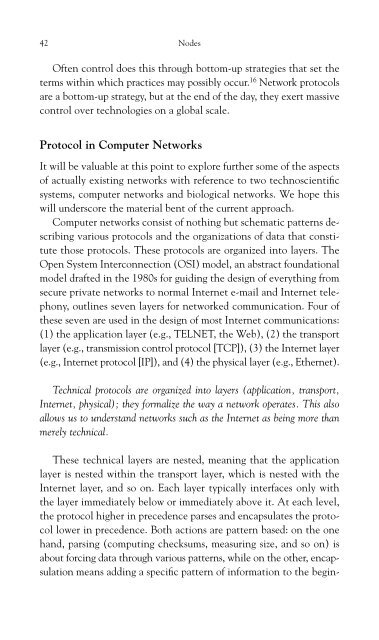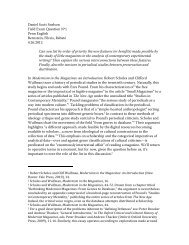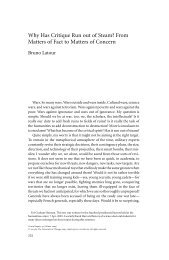The Exploit: A Theory of Networks - asounder
The Exploit: A Theory of Networks - asounder
The Exploit: A Theory of Networks - asounder
Create successful ePaper yourself
Turn your PDF publications into a flip-book with our unique Google optimized e-Paper software.
42 Nodes<br />
Often control does this through bottom - up strategies that set the<br />
terms within which practices may possibly occur. 16 Network protocols<br />
are a bottom - up strategy, but at the end <strong>of</strong> the day, they exert massive<br />
control over technologies on a global scale.<br />
Protocol in Computer <strong>Networks</strong><br />
It will be valuable at this point to explore further some <strong>of</strong> the aspects<br />
<strong>of</strong> actually existing networks with reference to two technoscientific<br />
systems, computer networks and biological networks. We hope this<br />
will underscore the material bent <strong>of</strong> the current approach.<br />
Computer networks consist <strong>of</strong> nothing but schematic patterns describing<br />
various protocols and the organizations <strong>of</strong> data that constitute<br />
those protocols. <strong>The</strong>se protocols are organized into layers. <strong>The</strong><br />
Open System Interconnection (OSI) model, an abstract foundational<br />
model drafted in the 1980s for guiding the design <strong>of</strong> everything from<br />
secure private networks to normal Internet e - mail and Internet tele -<br />
phony, outlines seven layers for networked communication. Four <strong>of</strong><br />
these seven are used in the design <strong>of</strong> most Internet communications:<br />
(1) the application layer (e.g., TELNET, the Web), (2) the transport<br />
layer (e.g., transmission control protocol [TCP]), (3) the Internet layer<br />
(e.g., Internet protocol [IP]), and (4) the physical layer (e.g., Ethernet).<br />
Technical protocols are organized into layers (application, transport,<br />
Internet, physical); they formalize the way a network operates. This also<br />
allows us to understand networks such as the Internet as being more than<br />
merely technical.<br />
<strong>The</strong>se technical layers are nested, meaning that the application<br />
layer is nested within the transport layer, which is nested with the<br />
Internet layer, and so on. Each layer typically interfaces only with<br />
the layer immediately below or immediately above it. At each level,<br />
the protocol higher in precedence parses and encapsulates the protocol<br />
lower in precedence. Both actions are pattern based: on the one<br />
hand, parsing (computing checksums, measuring size, and so on) is<br />
about forcing data through various patterns, while on the other, encapsulation<br />
means adding a specific pattern <strong>of</strong> information to the begin-









